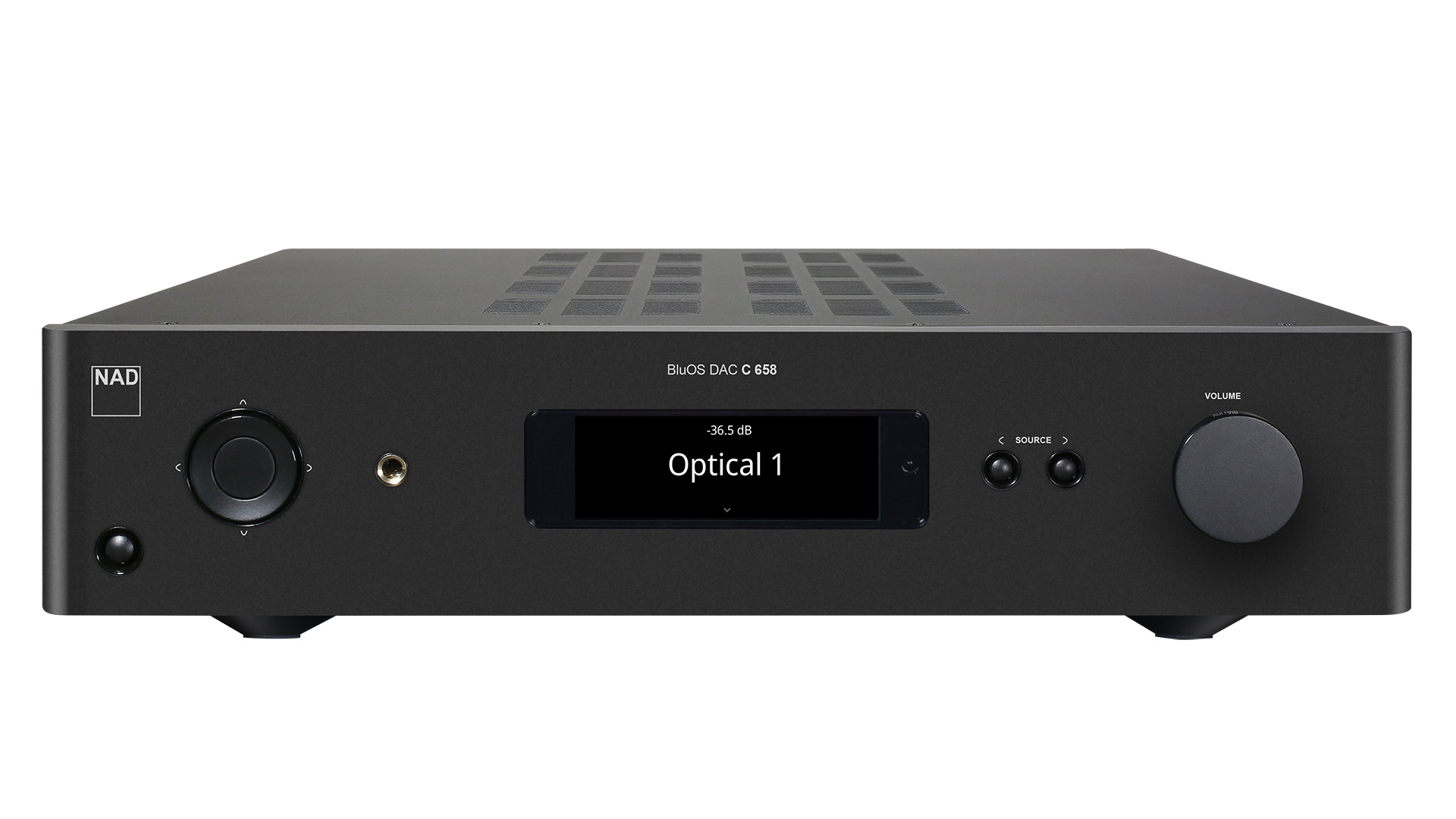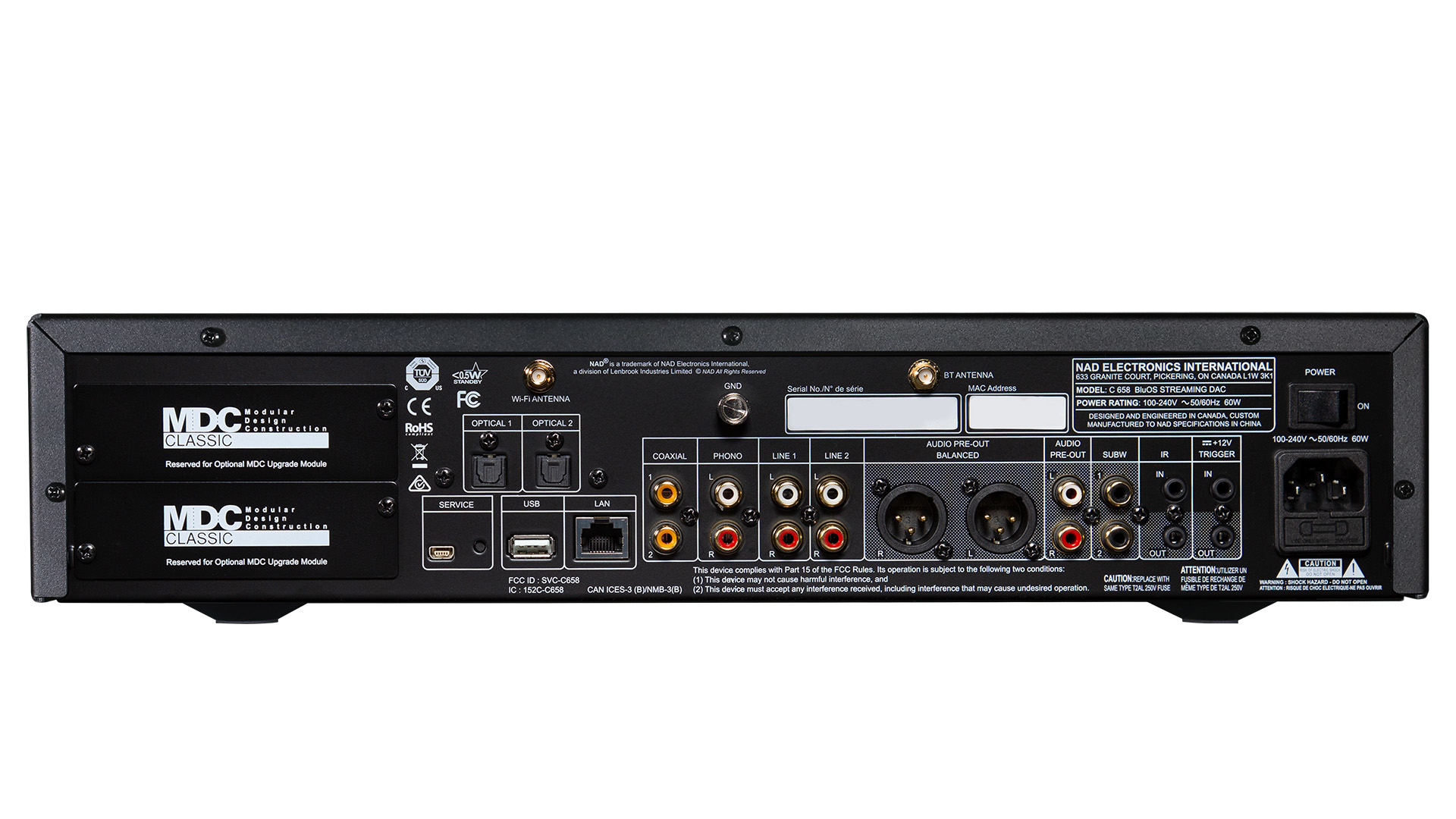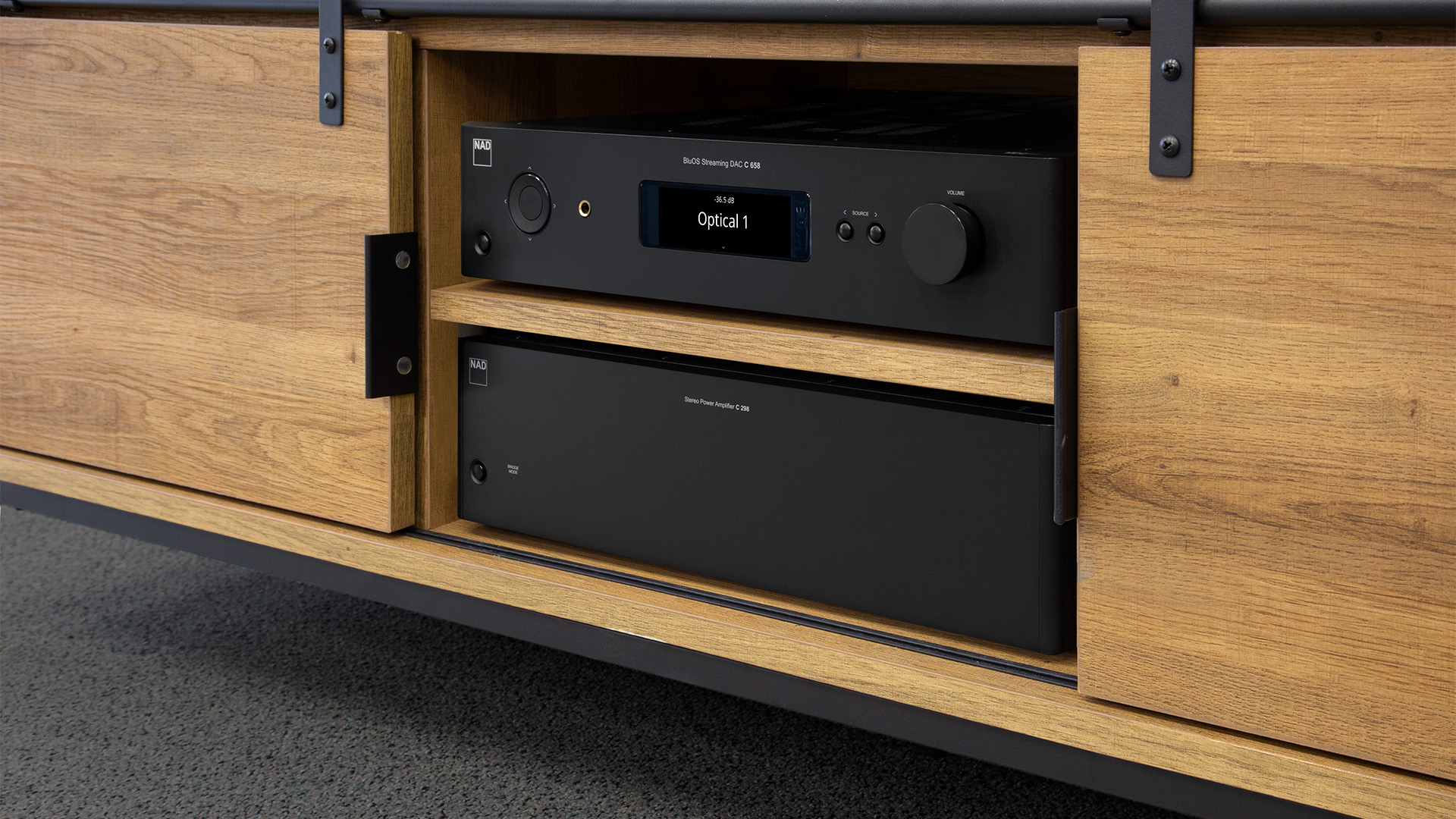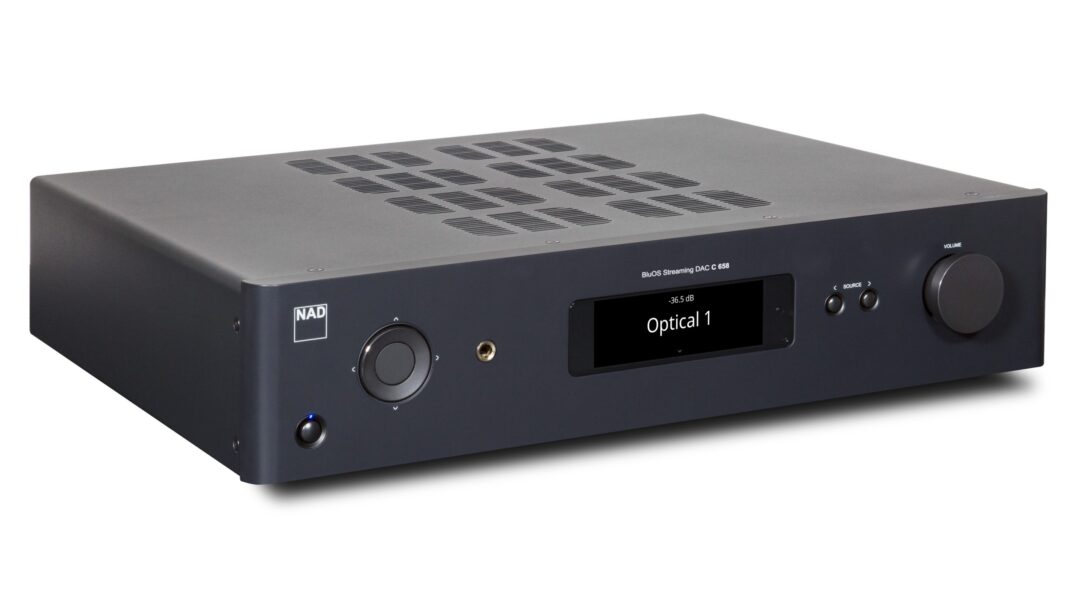Most amplifiers that we encounter are of the integrated type, ie where everything is gathered in one unit. But there are still some who swear by having a pure preamplifier. Either because they have special requirements for the power amplifier, or because it has to be combined with active speakers.
The NAD C658 is a preamplifier in the price range just below the point where hi-fi really beomes painful. It looks like a classic NAD: a gray-black box without any decoration. The humble look is likely to please true NAD fanatics, while others will see it as decidedly unsexy. In any case, it is far less conspicuous than the M10 and M33, with which it has Bluesound and Dirac Live room correction in common.
On the front we find a volume button (of course in plastic), two push buttons for source selection and a navigation wheel for selecting menu functions. A minimalist display tells what you need for daily use, but the setup process requires a lot of scrolling around.

A new type of component
NAD describes the C658 as “a new type of stereo component”. In the sense that it is a preamplifier and can receive (network) radio, it might fall into the category of “preceiver”. There are not many of those, but they do exist. Or it can be considered as a DAC/preamplifier due to the built-in digital converter. We have actually seen a fair amount of those.
However, mincing words should deter from the fact that we are dealing with a quite versatile device that can be both a signal source in itseelf and a center for all your other analog and digital audio sources.
On the analog side, there are two sets of line inputs and – more importantly – a turntable input (RIAA). However, it only supports MM pickups.
Two types of digital inputs are missing, namely the professional AES/EBU and USB-B (where the DAC acts as an external sound card for a computer). This can be solved to a certain extent, as the NAD C658 can be expanded with the so-called MDC modules (Modular Design Construction), of which there is room for two. At the time of writing, the only relevant modules are a USB-B port module with support for DSD files and an HDMI module that allows access to use the amplifier for home theater. But of course only in stereo and without surround decoding.
Streaming
But in reality, most people are not going to use the array of inputs very much, as most of it is done wirelessly. The NAD C658 has built-in Bluesound, which is NAD’s multi-room system in competition with Sonos, HEOS and Google Home. And regardless of whether you buy the amplifier with the premise of pampering the turntable and the vinyl collection, the input selector will probably in practice be set to Bluesound most of the time to listen to net radio or stream from one of the music streaming services.
If you select Tidal, the C658 also supports the high-resolution MQA format used on the Tidal HiFi Master recordings.
You can stream to C658 from your mobile with Apple AirPlay 2 and Bluetooth. The latter is two-way, so you can use wireless headphones with the amplifier. And since the aptX HD protocol is supported, the sound quality can be quite acceptable.

Dirac Live
The room correction is, like on the NAD M33 and NAD M10, Dirac Live. And like them, this is the basic version, where corrections are only made below 500 Hz. This feels a bit cheap, and NAD could easily have put another 100 GBP on top of the price of the amplifier without causing any raised eyebrows here – and then have given us a “free” full version of Dirac.
That said, the low frequencies are where room correction comes most into its own, and at the same time also where the chance of a good result is greatest.
The measurement of the room is similar to that found on surround receivers, except that you have to do without on-screen menus on the TV. This is done instead via the Dirac mobile app and the included measuring microphone.
When measured from a total of nine measuring points in the space around the listening position, a correction curve is calculated, which is stored in the amplifier. You can both view and adjust the proposed frequency curve on the mobile screen.
And the difference is huge! You only realize how much room acoustics affects the bass when it stops! Or at least when the effect is being diminished. Peaks in the bass area can be tamed, but deep dips due to phasing out are out of reach, as you will only manage to overload the power amplifier and speakers. In addition to a cleaner bass reproduction, the room correction also makes it possible to hear details in the midrange range that were previously overshadowed.

The sound quality
With so many similarities in functions, it is reasonable to think that acoustically there should also be a close relationship between the NAD C658 and the preamplifier part in the M33, M32 or M10. We’re not quite up there, but it’s close.
Compared to the preamplifier part in the M32, there is a slightly less of the cool sobriety in the C658. There is not quite the same precision in the dimensions of the acoustic scene. But the differences are small. And in practice, the choice of one or the other power amplifier characterizes the whole much more. Not in the sense that the preamplifier does not matter. But the fingerprint from the power section of the M33, M32 or the C298, the last two of which we also have in the test room at the moment, is far more pronounced.
First of all, the NAD C658 is quite easy to listen to. There are no tonal ranges that are particularly exposed or disadvantaged. When the bass seemed either heavy or slim, the reason was more the connected power stage.
The acoustic scene that is drawn up is a little more forward-looking, and the soloists are a little more inside the room rather than behind the speakers. This is neither right nor wrong (and the difference between the recordings characterizes the scenery far more than the amplifier itself), but the slightly greater closeness makes it easier to immerse oneself in the music instead of counting seats in the orchestra. And that, in the end, is what music listening should be about.
The competitors for the C658 are few, so in that way one must give NAD the right in that it is a new type of component. You will find very few separate preamplifiers outside the expensive high end segment. And none of them have the option of multiroom streaming. Not to mention built-in room correction.
The closest to a competitor is probably an integrated amplifier with streaming, such as the Hegel H120. Or a NAD C388 with the Bluesound expansion. In both cases, you get a power amplifier with the purchase, but without the important room correction. Naim Unity Atom is a very competent streaming amplifier, but also costs a lot more than the NAD C658. However, no more than that and a matching power amplifier.
Conclusion
The NAD C658 ranks midway between the company’s regular no-nonsense models and the more polished Masters high-end range. No expense has been spent on the exterior design, but it is well stocked with advanced solutions inside the cabinet.
With streaming and multi-room sound via BluOS as well as room correction, the C658 can become an excellent focal point for a digital system. And the turntable input will be the decisive argument for many – but not owners of MC cartridges. It is an obvious choise to combine it with the power amplifier C298. In which case, you will get a performance that comes close to the integrated M33, but a quarter cheaper.

We think
Built-in Bluesound streaming and room correction. Can be expanded with additional features. Turntable input. Together with a capable power amplifier, the price comes close to or above some of the models in the NAD Master series.
1499 €
Specifications
- Digital inputs: 2 x coaxial, 2 x optical (TOSLINK), USB Type A, Ethernet
- Analog inputs: 2 x Line in (stereo RCA), turntable (MM / MC) (stereo RCA)
- Outputs: Pre out (stereo RCA), pre out, balanced (stereo XLR), subwoofer (stereo
- RCA), headphones
- Wireless: AirPlay 2, Bluetooth 5 (aptX HD) 2-way, Wi-Fi 5
- Streaming (BluOS): Spotify, Amazon Music, TIDAL, Deezer, Qobuz, HDtracks, HIGHRESAUDIO, Murfie, JUKE, Napster, Slacker Radio, KKBOX, Bugs, TuneIn Radio, iHeartRadio, Calm Radio, Radio Paradise
- Resolution: 24 bit / 96 kHz (optical) 24 bit / 192 kHz (coaxial)
- Formats: MQA (up to 24 bit / 96 kHz), FLAC, WAV, AIFF, WMA (incl. Lossless), AAC,
- OGG, ALAC, MP3, OPUS
- Room correction: Dirac Live basic version, measuring microphone included
- Remote control: Remote control, BluOS app (Android/iOS)
- Dimensions and weight: 43.5 x 10 x 40.5 cm/7.4 kg
- Web: hifiklubben.dk

